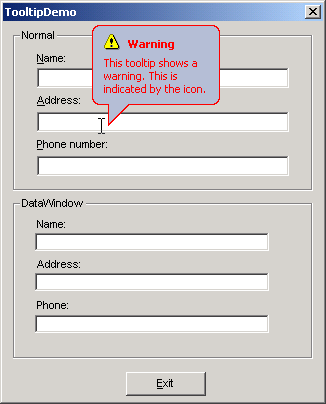![]()
| Author | Rui Cruz (and for a part Aart Onkenhout) |
| Date | 10-05-2001 |
A frequently asked question is: how to show tooltips with PowerBuilder. With this tip comes a user-object (n_tooltip) to achieve this using the tooltip-control that's available via comctl32.dll. The fundamentals of this control are developed by Rui Cruz. A couple of functions I added to it myself. These ones are described in the remainder of this tip.

You create a Tooltip-Window by just adding it as an instance variable to your, e.g., window. After this you have to register controls you want to be able to use the Tooltip-Window. You can do this by calling:
inv_Tooltip.of_AddTool( DragObject ado_Object, String as_TipText, Integer ai_Flags )
If you have a very long text for your tooltip you would like to split it in more than one line. You can do this by sending a TTM_SETMAXTIPWIDTH message. This tells your tooltip-window to split the tooltiptext in more than one line when the length of the text exceeds the width set by this message.
Call of_SetMaxWidth( Long al_MaxWidth ) to accomplish this.
By changing the code in the Constructor-event of n_tooltip you can create Tooltips with rounded corners and a stem pointing to the item.
hWndTT = CreateWindowExA( WS_EX_TOPMOST,TOOLTIPS_CLASS,0, TTF_CENTERTIP +
TTS_BALLOON + 1, &
CW_USEDEFAULT, CW_USEDEFAULT, CW_USEDEFAULT, CW_USEDEFAULT, &
0, 0, Handle( GetApplication() ), 0 )
The functions of_SetTipBkColor and of_SetTipTextColor make it possible to change the backgroundcolor and the textcolor respectively. Just call them with the desired color.
By calling of_SetTitle( Integer ai_icon, String as_Title ) you can add a title and, if you wish, an icon. You can use 4 values for ai_Icon:
TTI_NONE ( 0 ), TTI_INFO ( 1 ), TTI_WARNING ( 2 ) or TTI_ERROR ( 3 ).
Your call can look like:
inv_Tooltip.of_SetTitle( inv_Tooltip.TTI_WARNING, "Warning" )

You can use the tooltip-control with a DataWindow (see the example in the zip-file). However, when the focus is on an editable field the tooltip won't appear because the mousemove-event isn't fired.
of_RemoveTool
An idea coming from Jim Egan (TeamSybase): add an of_RemoveTool function. To give the user the opportunity to switch tooltips on and off, a new function was added. To switch the tooltip of for a certain control, call of_RemoveTool. Arguments are the control itself and the identity returned by of_AddTool. So, if you want to remove tooltips, you have to remember the identities returned.
Mousemove-event
You don't have to add a mousemove event to every control you add a tooltip for, i.e. when two conditions are met:
| The tool is a control or is defined as a rectangle in the tool's ToolInfo structure. | |
| The window associated with the tool is in the same thread as the ToolTip control. |
If these two conditions are met, messages are relayed automatically to the tooltip control when you set the uFlags field of the ToolInfo structure to TTF_SUBCLASS ( = 16 ).
In other cases, you have to call of_RelayMsg to make mouse-messages be sent to the tooltip control.
Added coding to show tooltips on a tabular datawindow for every row and column (as I read very often on the PowerBuilder forums).
07-06-2005: Thierry Decamps discovered you have to call of_addtool again after resizing a datawindow otherwise the tooltips won't show up again (i.e. not for all columns). You can add coding for this within the resize event. First call of_RemoveTool then call of_AddTool.
Another addition is the possibility to change delaytimes. There are three delaytimes:
TTDT_AUTOPOP: Retrieve the amount of time the ToolTip window remains visible if the pointer is stationary within a tool's bounding rectangle.
TTDT_INITIAL: Retrieve the amount of time the pointer must remain stationary within a tool's bounding rectangle before the ToolTip window appears.
TTDT_RESHOW: Retrieve the amount of time it takes for subsequent ToolTip windows to appear as the pointer moves from one tool to another.
Use the function of_SetDelayTime( Integer ai_Duration, Integer ai_Milliseconds ) to set each of these times.
Check the updated sample for an example.